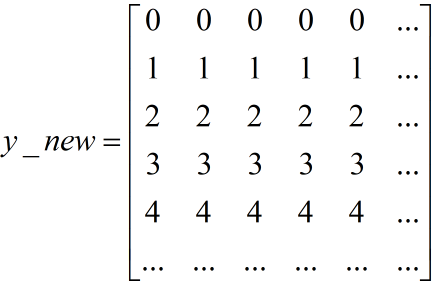图像仿射变换 图像平移 python实现
写文章不易,如果您觉得此文对您有所帮助,请帮忙点赞、评论、收藏,感谢您!
一. 仿射变换介绍:
请参考:图解图像仿射变换:https://www.cnblogs.com/wojianxin/p/12518393.html
二. 仿射变换 公式:

仿射变换过程,(x,y)表示原图像中的坐标,(x',y')表示目标图像的坐标 ↑
三. 仿射变换——图像平移 算法:

仿射变换—图像平移算法,其中tx为在横轴上移动的距离,ty为在纵轴上移动的距离 ↑
四. python实现仿射变换——图像平移
import cv2
import numpy as np
# 图像仿射变换->图像平移
def affine(img, a, b, c, d, tx, ty):
H, W, C = img.shape
# temporary image
tem = img.copy()
img = np.zeros((H+2, W+2, C), dtype=np.float32)
img[1:H+1, 1:W+1] = tem
# get new image shape
H_new = np.round(H * d).astype(np.int)
W_new = np.round(W * a).astype(np.int)
out = np.zeros((H_new+1, W_new+1, C), dtype=np.float32)
# get position of new image
x_new = np.tile(np.arange(W_new), (H_new, 1))
y_new = np.arange(H_new).repeat(W_new).reshape(H_new, -1)
# get position of original image by affine
adbc = a * d - b * c
x = np.round((d * x_new - b * y_new) / adbc).astype(np.int) - tx + 1
y = np.round((-c * x_new + a * y_new) / adbc).astype(np.int) - ty + 1
# 避免目标图像对应的原图像中的坐标溢出
x = np.minimum(np.maximum(x, 0), W+1).astype(np.int)
y = np.minimum(np.maximum(y, 0), H+1).astype(np.int)
# assgin pixcel to new image
out[y_new, x_new] = img[y, x]
out = out[:H_new, :W_new]
out = out.astype(np.uint8)
return out
# Read image
image1 = cv2.imread("../paojie.jpg").astype(np.float32)
# Affine : 平移,tx(W向):向右30;ty(H向):向上100
out = affine(image1, a=1, b=0, c=0, d=1, tx=30, ty=-100)
# Save result
cv2.imshow("result", out)
cv2.imwrite("out.jpg", out)
cv2.waitKey(0)
cv2.destroyAllWindows()
五. 代码实现过程中遇到的问题:
① 原图像进行仿射变换时,原图像中的坐标可能超出了目标图像的边界,需要对原图像坐标进行截断处理。如何做呢?首先,计算目标图像坐标对应的原图像坐标,算法如下:

目标图像坐标反向求解原图像坐标公式 ↑
以下代码实现了该逆变换:
# get position of original image by affine
adbc = a * d - b * c
x = np.round((d * x_new - b * y_new) / adbc).astype(np.int) - tx + 1
y = np.round((-c * x_new + a * y_new) / adbc).astype(np.int) - ty + 1
然后对原图像坐标中溢出的坐标进行截断处理(取边界值),下面代码提供了这个功能:
x = np.minimum(np.maximum(x, 0), W+1).astype(np.int)
y = np.minimum(np.maximum(y, 0), H+1).astype(np.int)
原图像范围:长W,高H
② 难点解答:
x_new = np.tile(np.arange(W_new), (H_new, 1))
y_new = np.arange(H_new).repeat(W_new).reshape(H_new, -1)

x_new 矩阵横向长 W_new,纵向长H_new ↑

y_new 矩阵横向长 W_new,纵向长H_new ↑
造这两个矩阵是为了这一步:
# assgin pixcel to new image
out[y_new, x_new] = img[y, x]
六. 实验结果:

原图 ↑

仿射变换—图像平移后结果(向右30像素,向上100像素) ↑
七. 参考内容:
① https://www.cnblogs.com/wojianxin/p/12519498.html
② https://www.jianshu.com/p/1cfb3fac3798
八. 版权声明:
未经作者允许,请勿随意转载抄袭,抄袭情节严重者,作者将考虑追究其法律责任,创作不易,感谢您的理解和配合!
作者:Ibelievesunshine